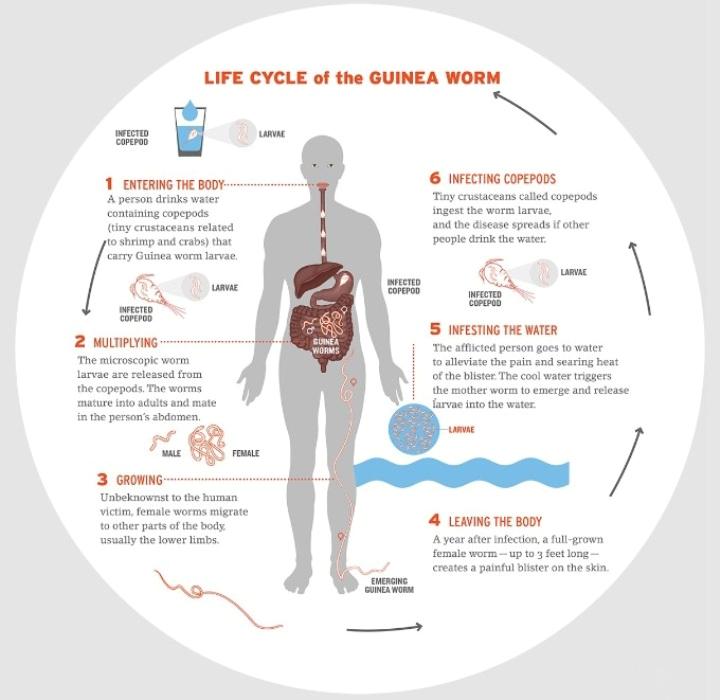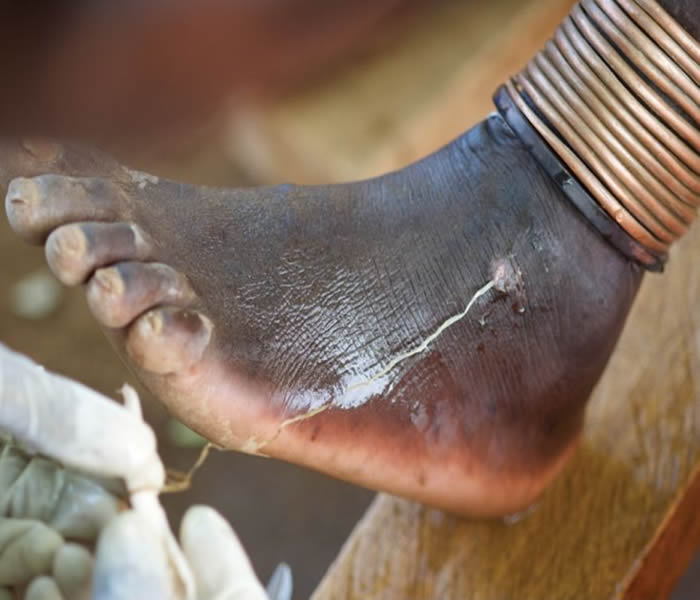GUINEA WORM
Guinea Worm Disease (Dracunculiasis)
Guinea-worm disease is caused by the parasitic worm Dracunculus medinensis or "Guinea-worm". This worm is the largest of the tissue parasite affecting humans.
People become infected with Guinea worm by drinking water from ponds, Stream and other stagnant water containing tiny "water fleas"
carry the Guinea worm larvae.
The larvae are eaten by the water fleas that live in these water sources.

Symptoms/Signs of Guinea Worm Disease
The first symptoms are Malaria-like:
- Absolutely no energy/Tiredness
- Chills
- Fever
- Nausea
The worm would forms a large burning skin ulcer, causing intense, localized pain. As soon as the ulcer forms, you would not be able to move that part of the body.
In the middle of the ulcer, a blister forms where the worm emerges. It takes at least 10 days for the worm to exit. If it in the leg there is no way you can walk with it after ten to eleven day.
How to diagnose Guinea Worm Disease/How to Know that You have Guinea Worm Disease

Guinea worm Diagnosis is usually made by clinical examination of patient seeing the adult worm protruding from a skin sore. A test would be carried out on the wound.
- In suspected cases – especially in endemic areas person showing boil/blister on leg.
- Confirmation by examination of protruding Guinea worm from skin lesions.
Filter your water before you drink. You can use the pipe filter, which looks and acts like a straw, is portable and easy to use.
There is a filter cloth on the end of the straw far from the mouth that sieves out the fleas carrying the Guinea worm larvae.
Other methods include teaching people to stay out of public water. Anyone who has an emergent guinea worm should not go into the water this is because he or she is shedding millions of Guinea worm larvae which other people can contact.
Treatment (Cure) for Guinea Worm Disease
No drug is available to prevent or heal this parasitic. Once part of the worm begins to come out of the wound, the rest of the worm can only be pulled out a few centimeters each day by winding it around a piece of gauze or a small stick. Sometimes the whole worm can be pulled out within a few days, but this process usually takes weeks. Medicine, such as aspirin or ibuprofen, can help reduce pain and swelling. Antibiotic ointment can help prevent secondary bacterial infections. The worm can also be surgically removed by a trained doctor in a medical facility before a blister forms.
Guinea Worm Disease Home Remedies/Home Cure
Dipping/Submersion of the affected area in a bucket of water this causes the worm to discharge many of its larva (worms) making it less painful. Make sure you pour the water away far from any water source.




